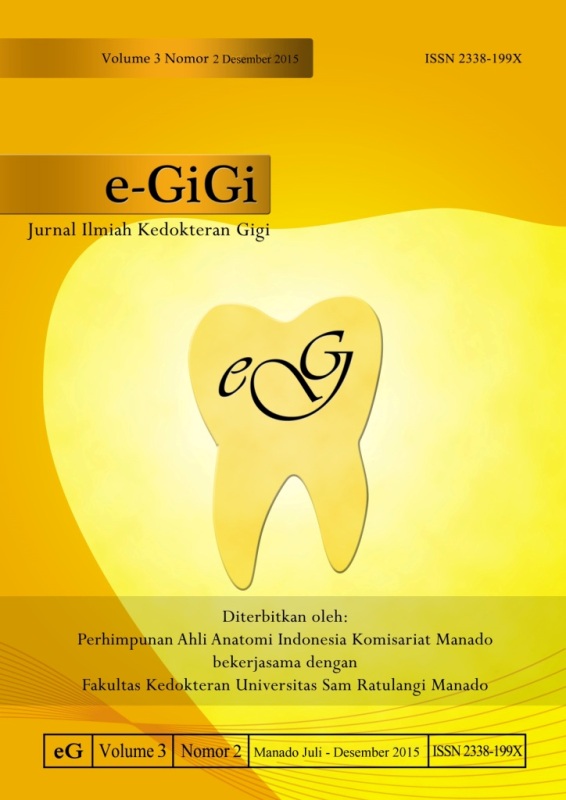UJI KEKERASAN RESIN KOMPOSIT AKTIVASI SINAR DENGAN BERBAGAI JARAK PENYINARAN
DOI:
https://doi.org/10.35790/eg.3.2.2015.10010Abstract
Abstract: Composite resin is a dental material which is used to fix the caries teeth because it have good esthetic and hardness. Visible light cured (VLC) composite resin hac better polymerization than chemical reaction composite resin. However, it does not have any abutment, therefore, the distance between light source and the composite surface is mostly ignored by the operator. Lightning process is very important to obtained good polymerization, so that the composite has enough hardness to hold back human masticate pressure. Composite which does not have enough hardness will be easily cracked. This study aimed to find out the correct distance of polymerization so that the composite resin has enough hardness to hold back human masticate pressure. This study used a post-test only design group and was conducted at the Laboratory of Metalurgy University of Sam Ratulangi. There were 27 samples of nanohybrid composite resin obtained by using a purposive sampling method. The measurement used was the Vickers method and micro Vickers hardness tester. The results showed that the group that had the highest hardness value was the first group with a lightning distance of 0 mm or light source touching composite resin surface, the value of hardness was 841.49 N/mm2. This value step by step decreased because the lightning distance increased, so that the lowest hardness value is 290,95 N/mm2 which on ninth group. Conclusion: The lightning distance of nanohybrid composite resin which could hold back the maximum human masticate pressure was on distance 0-6 mm.
Keyword : distance of lightning, nanohybrid composite resin, hardness value.
Abstrak: Resin komposit merupakan bahan tumpatan yang sering digunakan dalam kedokteran gigi karena memiliki nilai estetis serta kekerasan yang baik. Resin komposit aktivasi sinar berpolimerisasi lebih baik daripada resin komposit aktivasi kimia, tetapi alat visible light cured (VLC) yang digunakan tidak memiliki dudukan sehingga jarak antara sumber sinar dengan permukaan komposit saat penyinaran sering diabaikan. Proses penyinaran sangat penting agar terjadi polimerisasi yang baik sehingga komposit memiliki kekerasan yang cukup untuk menahan tekanan kunyah manusia. Kekerasan yang tidak cukup dapat menyebabkan komposit mengalami cracking atau pecahnya tumpatan didalam mulut. Tujuan penelitian ini untuk mengetahui jarak penyinaran yang tepat agar resin komposit memiliki kekerasan yang cukup untuk menahan tekanan kunyah manusia. Metode penelitian yang digunakan adalah metode post-test only design group yang diukur pada resin komposit jenis nanohibrid dan dilakukan di Laboratorium Metalurgi Jurusan Teknik Mesin Universitas Sam Ratulangi, dengan sampel sebanyak 27 sampel. Pengambilan sampel dilakukan dengan metode purposive sampling dan pengukuran kekerasan komposit menggunakan metode Vickers dan alat micro vickers hardness tester. Hasil penelitian menunjukan bahwa kelompok yang memiliki nilai kekerasan tertinggi terdapat pada kelompok pertama dengan jarak penyinaran 0 mm atau sumber sinar menyentuh permukaan komposit dengan nilai kekerasan 841,49 N/mm2. Nilai kekerasan ini secara bertahap menurun seiring dengan bertambah jauh jarak penyinaran, sehingga nilai kekerasan paling rendah terdapat pada kelompok penyinaran 8 mm yaitu 230,95 N/mm2. Kesimpulan dari penelitian ini yaitu jarak penyinaran terhadap resin komposit jenis nanohibrid sehingga resin komposit memiliki kekerasan yang cukup untuk menahan tekanan kunyah maksimal manusia berkisar pada jarak 0-6 mm.
Kata kunci : jarak penyinaran, resin komposit nanohibrid, nilai kekerasan
Downloads
How to Cite
Issue
Section
License
COPYRIGHT
Authors who publish with this journal agree to the following terms:
Authors hold their copyright and grant this journal the privilege of first publication, with the work simultaneously licensed under a Creative Commons Attribution License that permits others to impart the work with an acknowledgment of the work's origin and initial publication by this journal.
Authors can enter into separate or additional contractual arrangements for the non-exclusive distribution of the journal's published version of the work (for example, post it to an institutional repository or publish it in a book), with an acknowledgment of its underlying publication in this journal.
Authors are permitted and encouraged to post their work online (for example, in institutional repositories or on their website) as it can lead to productive exchanges, as well as earlier and greater citation of the published work (See The Effect of Open Access).






